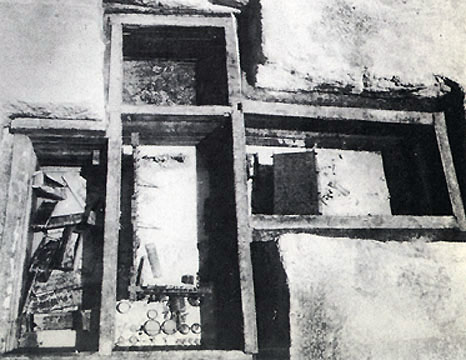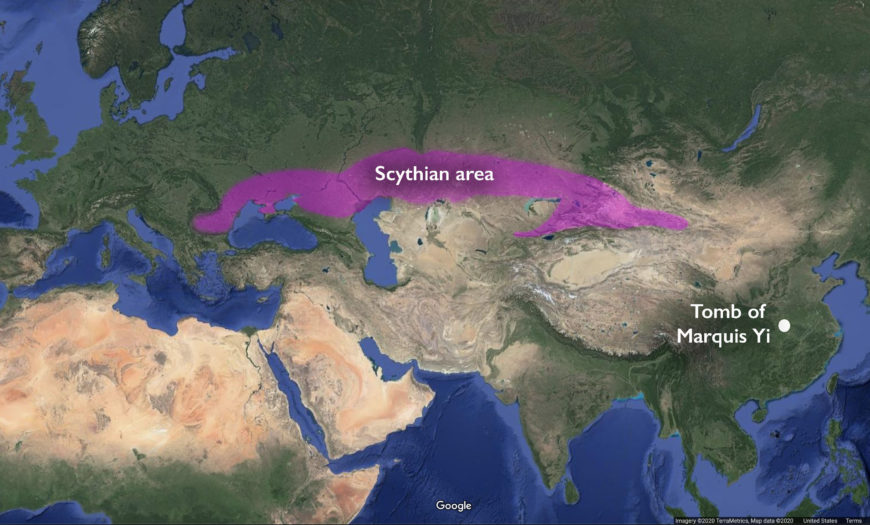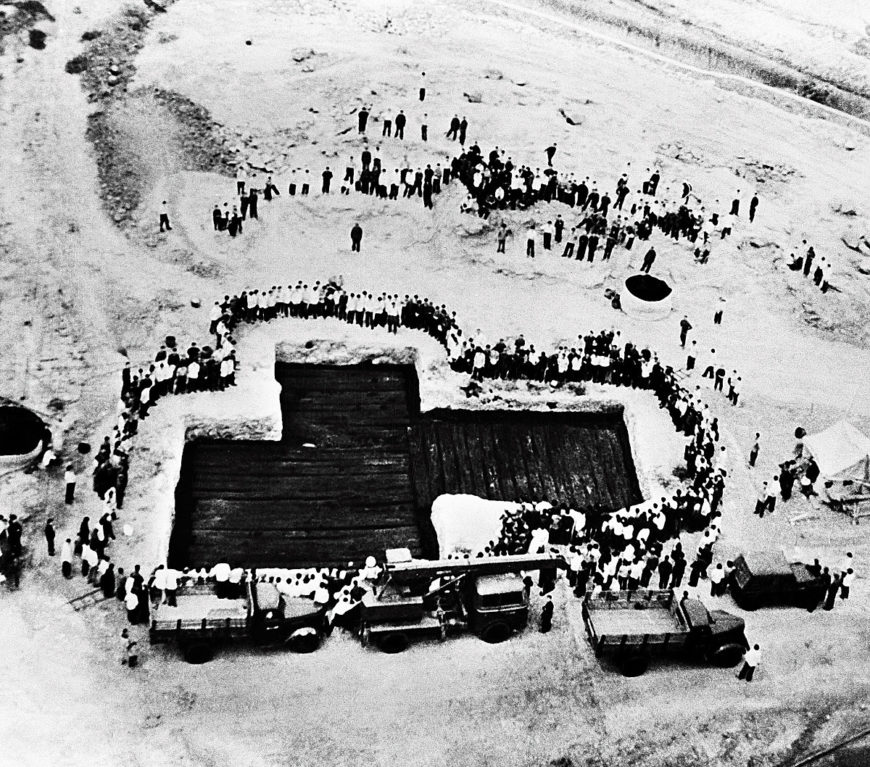
Excavation site of the tomb of Marquis Yi of Zeng (Leigudun Tomb 1), May 1978, Suixian, Hubei (Hubei Provincial Museum, Wuhan, China)
Imagine stumbling upon an undisturbed tomb filled with 15,000 items—from hundreds of jade and golden objects and enormous bronze wine vessels to massive lacquered coffins and a vast assortment of musical instruments. In 1978 in Leigudun, Suizhou, Hubei province, local military construction accidentally discovered such a luxurious tomb, one that was meant to impress. With all its contents still intact, this tomb (dating to the 5th century B.C.E during the Bronze Age) offers us a glimpse into how early burial customs and practices could not only reflect someone’s ambition, but also elevate their status.
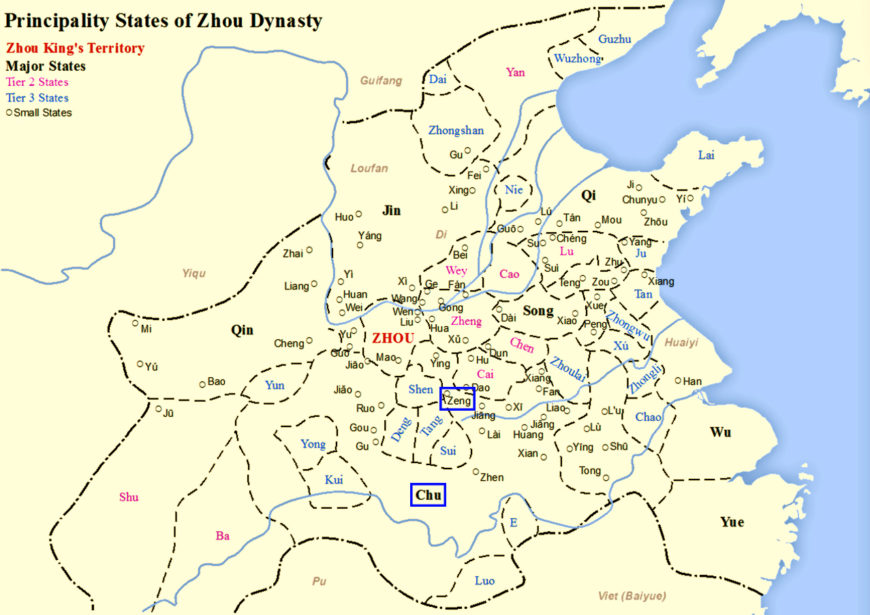
Map showing the many vassal states of the Zhou Dynasty in China. Zeng State is where Marquis Yi is from, and the larger more powerful Chu state interacted with Zeng state (map: SY, CC BY-SA 4.0)
Extensive bronze inscriptions suggest that the tomb owner was the Marquis Yi, who passed away in 433 B.C.E. or slightly later. He was of the Zeng state, a small southern state little known in the traditional historical record. Marquis Yi was active in the early Warring States period (481–221 B.C.E.), which witnessed the dissolution of the kin-shaped political system. Lords paid increasingly less respect to the nominal Zhou king, and they engaged in warfare against each other and competed for higher status and prestige.
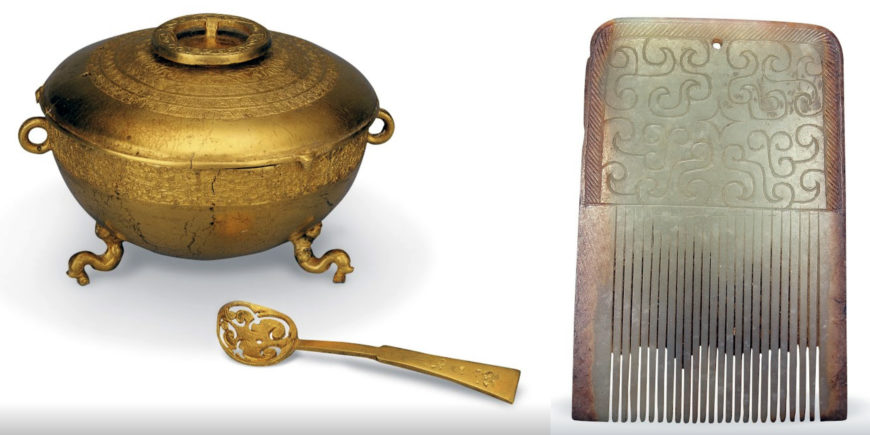
Gold food container and jade comb that was placed underneath Marquis Yi’s head, Tomb of Marquis Yi of Zeng (Leigudun Tomb 1), Warring States period, late 5th century B.C.E., Suixian, Hubei, China (Hubei Provincial Museum)
Despite the turbulence of this era, the luxurious furnishings from Marquis’s tomb with its overt display of wealth and power clearly reflect his ambition. The number of bronzes from his tomb is unmatched by any other burials in pre-imperial China. He was also buried with a number of ritual bronze vessels normally reserved for the Zhou kings, further implying the marquis’s interest in attaining a more prominent status. Because most of the princely burials in the Warring States period have been looted, the integrity and wealth of Marquis Yi’s tomb offers a rare opportunity to examine the elite culture and funerary customs in the late first millennium B.C.E.
Tomb Structure
The tomb of Marquis Yi was originally more than 40 feet below surface level, with layers of charcoal, viscous, and dry soil piled on to it to protect it. It is one of the earliest examples in ancient China that demonstrates the desire to replicate aboveground living quarters in funerary practice. This practice was an attempt to sustain a person’s secular privileges and pleasures in the afterlife. Inside, the tomb is divided into four compartments, each with a different designated function and associated objects. Here is a basic list of what was found:
Central chamber: extensive bronze ritual vessels and musical instruments for grand ancestral offering ceremonies and court banquets
North chamber: Chariot fittings and weapons such as bows, ge-halberds, shields, and armor
East chamber: Marquis Yi’s main coffins surrounded by eight smaller coffins found with female human sacrifice victims and a coffin for a dog
West chamber: additional thirteen female human sacrifice victims.
The female victims in the tomb were approximately twenty years old, and were likely Marquis’s maids, musicians, and dancers. All these furnishings and the human entourage ensured that Marquis Yi would continue his sumptuous elite life after his death.
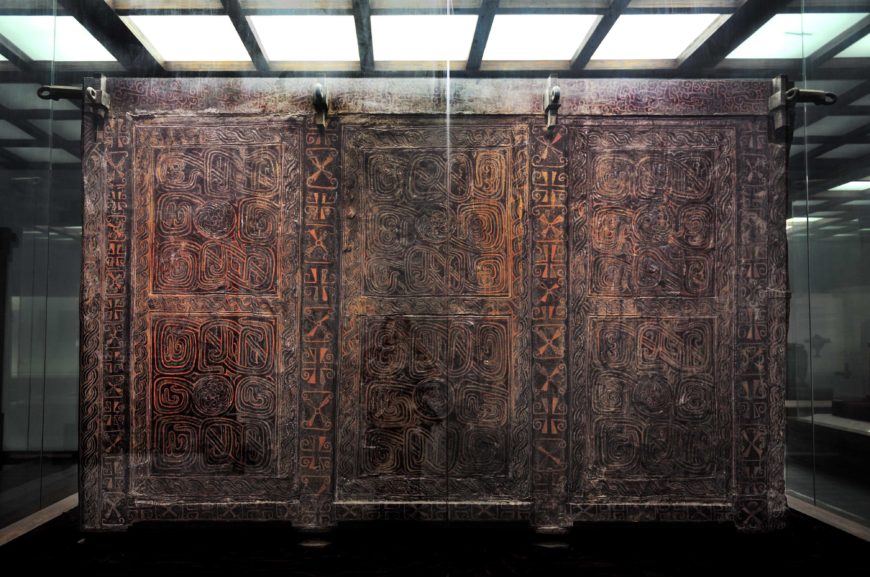
Outer coffin, Tomb of Marquis Yi of Zeng (Leigudun Tomb 1), Warring States period, late 5th century B.C.E., lacquered wood, 3.20 m in length, 2.10 m in width and 2.19 m in height, Suixian, Hubei, China (Hubei Provincial Museum; photo: Siyuwj, CC BY-SA 4.0)
Double coffins
Outer coffin
Marquis Yi rested in enormous double coffins, which are impressive for their sheer size, intricate patterns, and bright lacquer. The outer coffin is an enormous rectangular box. This exceptionally large wooden box even has a bronze framework to stabilize it. It has a black lacquer background, and is decorated with yellow and red intertwined serpents surrounding a central swirl. Abstract cloud motifs fill the border between the main units.
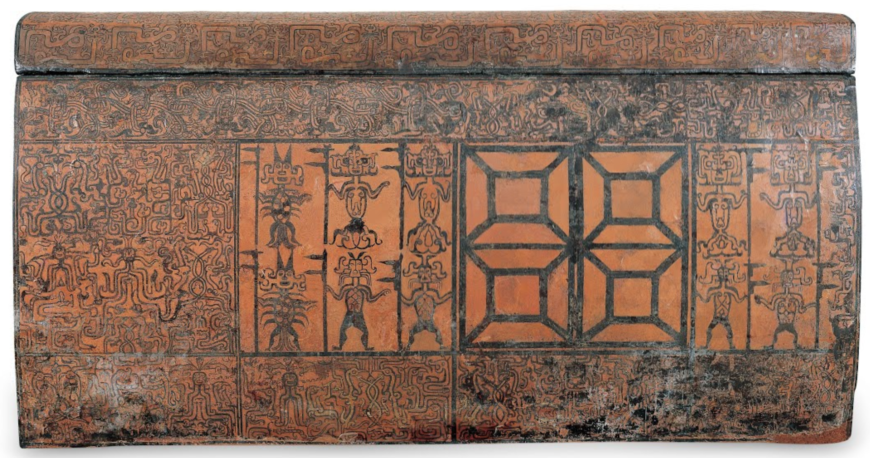
Inner coffin, Tomb of Marquis Yi of Zeng (Leigudun Tomb 1), Warring States period, late 5th century B.C.E., lacquered wood, 2.50 m long, 1.27 m wide and 1.32 m high, Suixian, Hubei, China (Hubei Provincial Museum)
Inner coffin
The inner coffin is considerably smaller in size, allowing its makers to construct it solely from wooden panels. Entangled serpents, birds, fish, and other composite animals decorate the surface. Spiritual beings in semi-animal form with weapons in hand also stand guard.

Window designs are flanked by horned figures holding weapons. Detail of inner coffin, (Leigudun Tomb 1), Warring States period, late 5th century B.C.E., lacquered wood, 2.50 m long, 1.27 m wide and 1.32 m high, Suixian, Hubei, China (Hubei Provincial Museum)
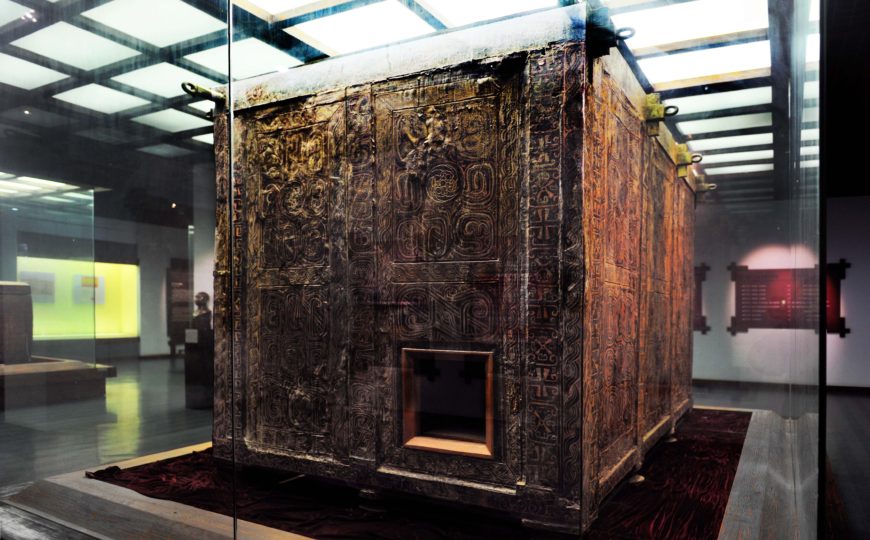
Outer coffin with a square hole at the north end of the tomb, Tomb of Marquis Yi of Zeng (Leigudun Tomb 1), Warring States period, late 5th century B.C.E., lacquered wood, 3.20 m in length, 2.10 m in width and 2.19 m in height, Suixian, Hubei, China (Hubei Provincial Museum; photo: Siyuwj, CC BY-SA 4.0)
Both coffins
A series of designs on both coffins facilitated the spirit of Marquis Yi to travel freely and continue to enjoy his unparalleled luxury in the afterlife. The Zeng craftsmen painted windows on the inner coffin. They also carved out a square hole on the lower right corner on the north end of the outer coffin. Similar square openings on the bottom of the tomb’s wooden walls further enable access to all the chambers. Marquis Yi could ride his chariot in the north chamber for an outing and hold a sumptuous royal banquet in his central chamber.
Lacquer production was costly and time consuming. Craftsmen extracted lacquer from the toxic sap of the lacquer tree that is indigenous to China. The hazardous production process and the time-consuming application of multiple layers of lacquer on an item’s surface led to the high price of lacquerware. Lacquer’s lightness, vibrant colors, and glossy surface made it as prestigious as ritual bronze vessels. Besides the coffins, the tomb also had an extensive collection of other lacquerwares—letting anyone know once again of Marquis Yi’s status.
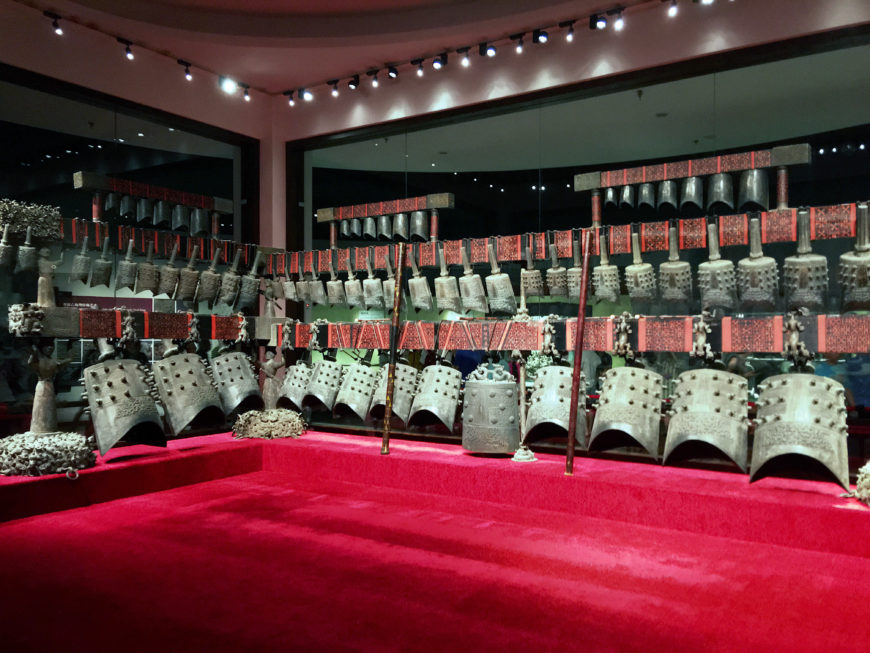
The chime bell set has 65 bells on three tiers. The largest chime bell is 152.30 cm high and weighs at 203.6 kg, the smallest is only 20.30 cm and 2.4 kg. Tomb of Marquis Yi of Zeng (Leigudun Tomb 1), Warring States period, late 5th century B.C.E., bronze and lacquer, Suixian, Hubei, China (Hubei Provincial Museum; photo: YouTable, CC BY-SA 4.0).
Chime Bell Set
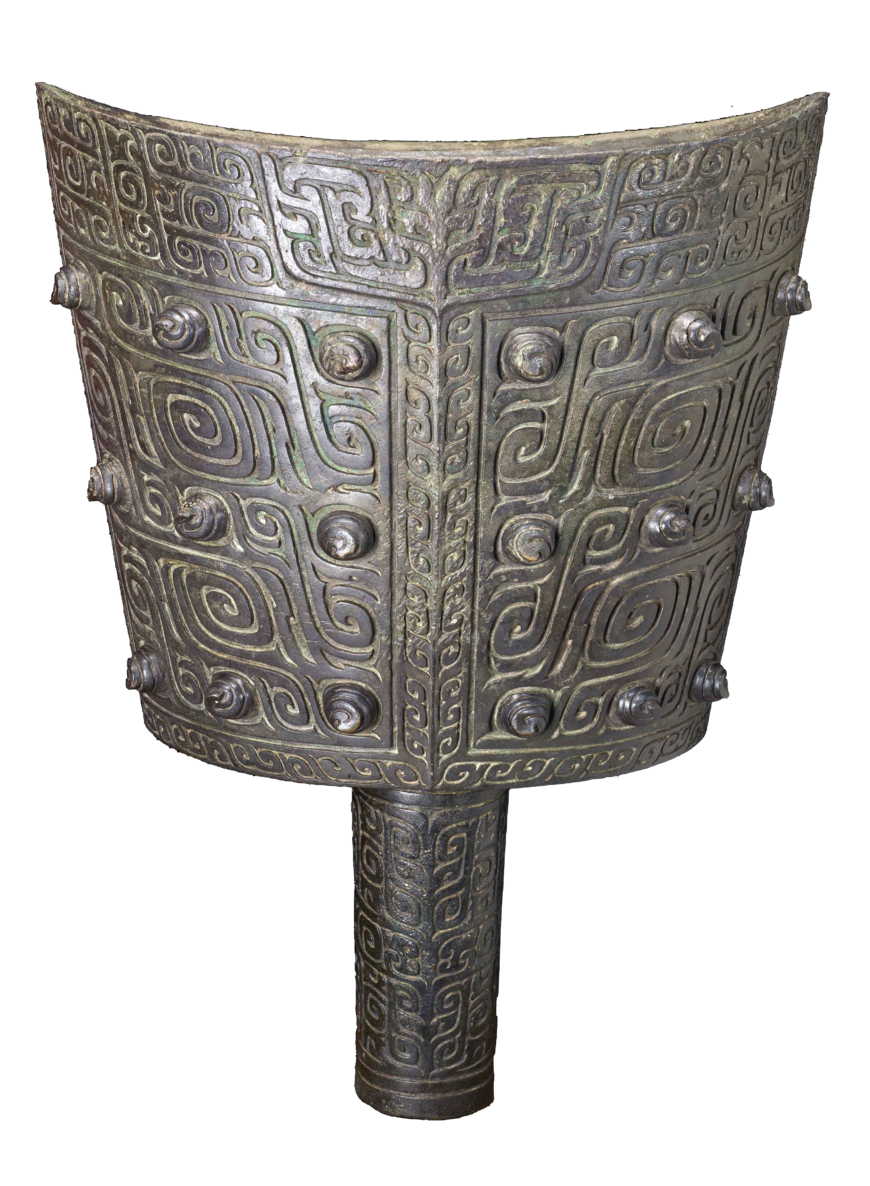
Hollow shaft bell (nao), Shang dynasty, c. 1200–1100 BCE, bronze, 70 x 52 x 35 cm, China, Yangzi River valley (Arthur M. Sackler Gallery)
The grand chime bell set is the largest item in the central chamber. In China, bronze musical bells trace their origin to the late second millennium B.C.E. clapperless nao-bells in the Yangtze River region in the south.
Western Zhou elites began to institutionalize chime bells in the 9th century B.C.E. Bells began to be organized to cover an octave, and musical theory gradually developed. This systematic change added an acoustic dimension to the visual and gustatory experiences in the ritual performance of ancestral offerings.
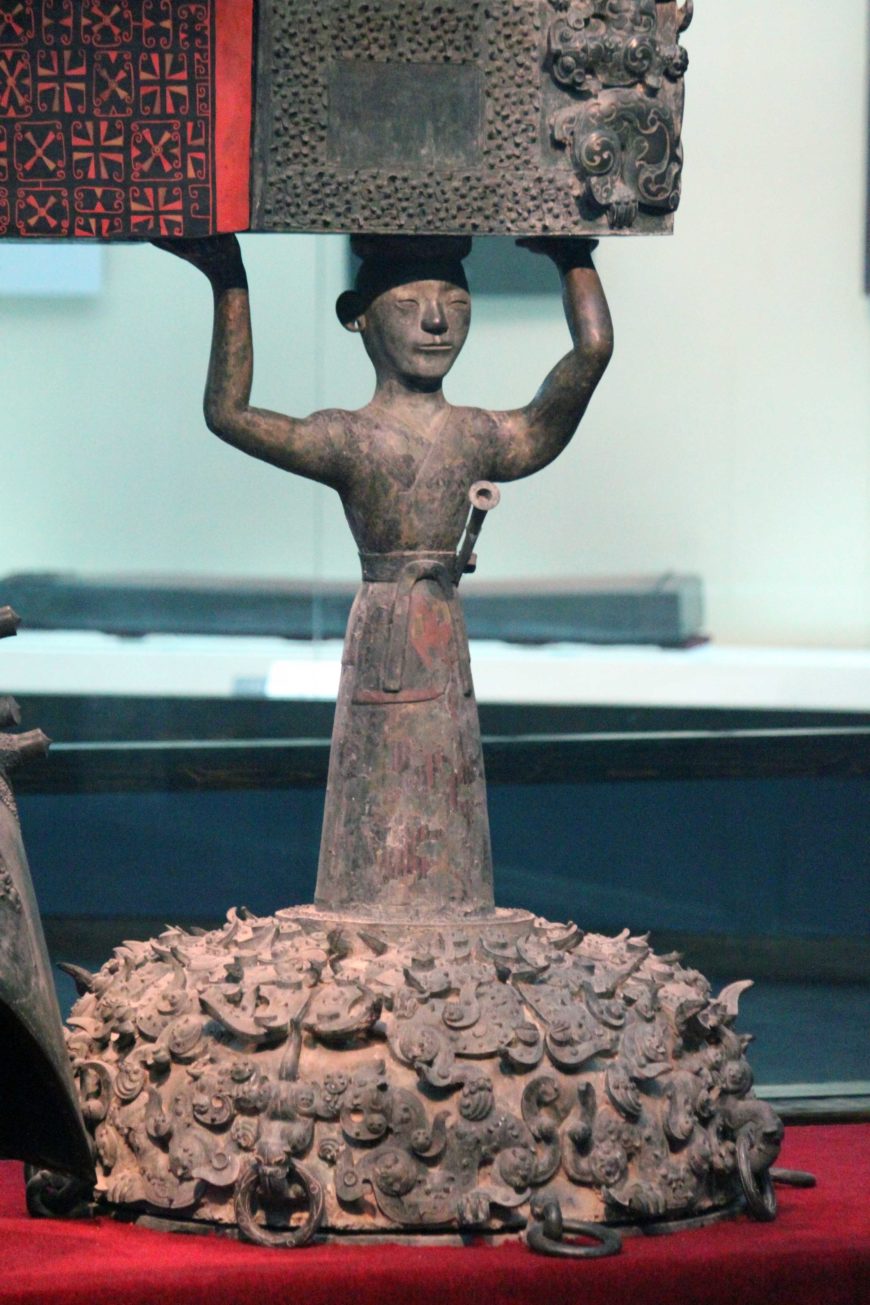
Bronze armed warrior holding up chime bells from the Tomb of Marquis Yi of Zeng (Leigudun Tomb 1), Warring States period, late 5th century B.C.E., Suixian, Hubei, China (Hubei Provincial Museum; photo: Gary Todd)
Marquis Yi’s bell set is the most extensive and best preserved known-to-date. Divided into eight groups, 65 bells occupy three tiers on L-shaped shelves. The wooden shelves, adorned by elaborate lacquer decoration and bronze components, are supported by six bronze statues of armed warriors. Unlike in Egypt and Mesopotamia in the third and second millennium B.C.E. where the appearance of the rulers was a major artistic theme, patrons and artists in early China almost purposefully eschewed direct human representations.
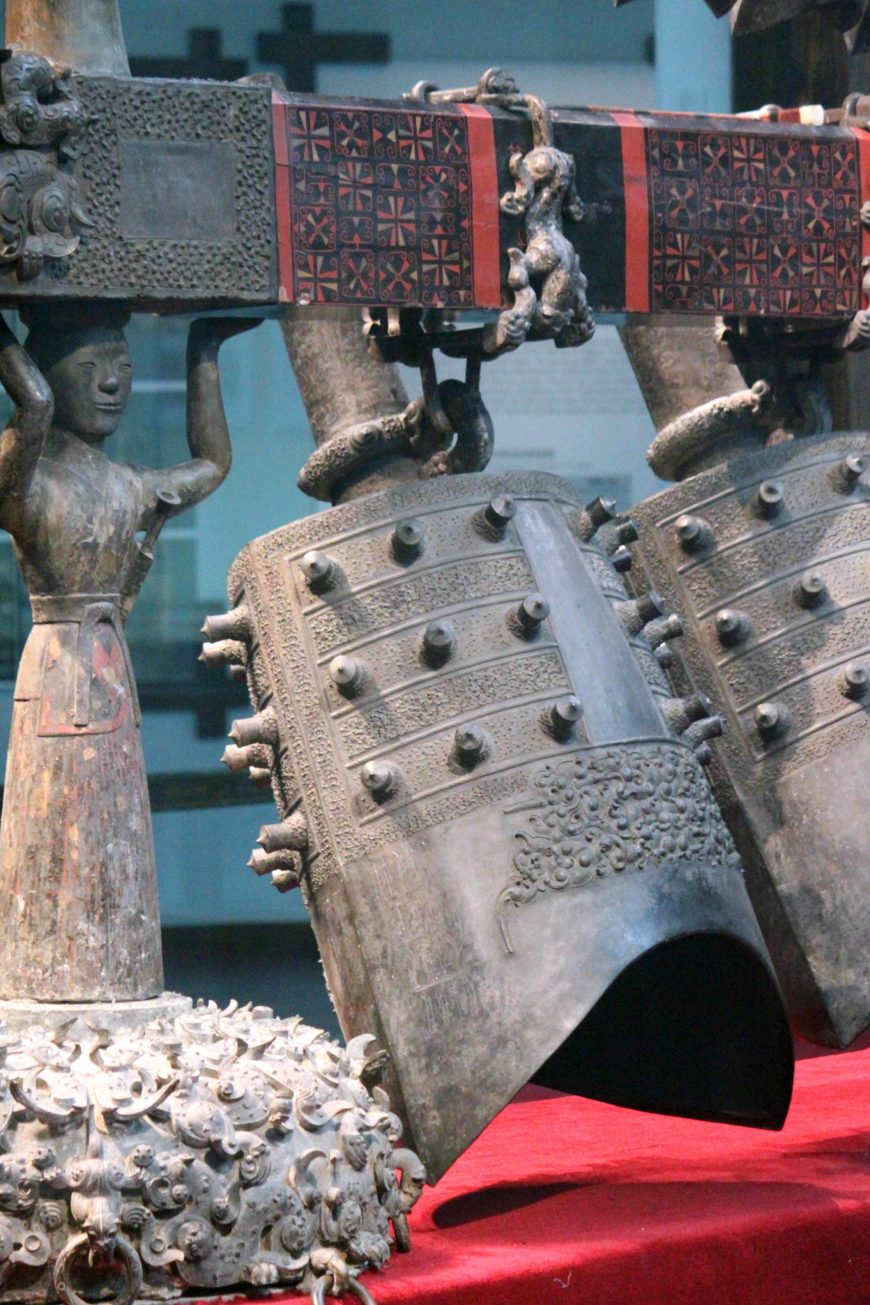
Bronze chime bell from the Tomb of Marquis Yi of Zeng (Leigudun Tomb 1), Warring States period, late 5th century B.C.E., Suixian, Hubei, China (Hubei Provincial Museum; photo: Gary Todd)
The bronze warriors in Marquis Yi’s bell set are a rare case of the representation of the human form in early Chinese art, indicative of the late first millennium trend toward increasing secularization. Scholars have proposed that the reason for this was that writing was ritually and politically more powerful than images in early China. We always see the name of the owner and that of the honored person cast on precious bronze vessels, but we almost never see the face of the patron in bronze art.
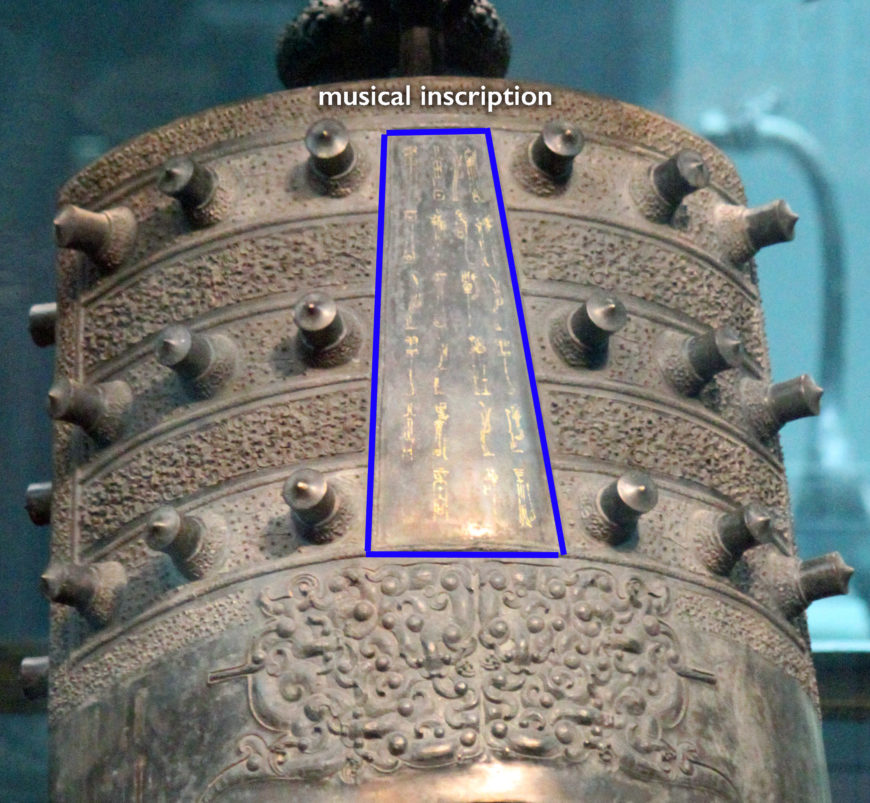
A golden musical inscription on the front of the bell details the pitch and scale of the bell. Chime bell from the Tomb of Marquis Yi of Zeng (Leigudun Tomb 1), Warring States period, late 5th century B.C.E., Suixian, Hubei, China (Hubei Provincial Museum; photo: Gary Todd)
The bells range considerably in weight and height. Interlaced serpents in a dense pattern and granular texture rise up in low relief from the bell surface. Musical inscriptions in gold script are on the center, bottom, and side of the bells. A total of 3,755 characters explain in detail the pitches and scales that the chime bells are designed to play. Each bell is tuned to produce two clear pitches by striking the center and side. The entire set is capable of playing a five-note scale across five octaves. Tuning bronze bells is a highly technical, challenging task. Experienced Zeng state founders skillfully cast the bells with approximately correct pitches.
Listen to what the bells would have sounded like with modern-day reconstructions (video by Behring Global Educational Foundation)
A grand chime bell set would have been the center of court musical performances. Additional musical instruments, such as a 32-piece stone chime set, wooden zithers, drums, flutes, panpipes, and mouth organs, completed the ensemble. The bell set alone required a crew of five players. More than 20 musicians were needed to perform in the orchestra. The enormous labor and material investment in the court banquet certainly impressed most guests of Marquis Yi. What is more profound is the exceptional sophistication and grandeur of the musical system. Marquis Yi conveyed a strong message: Not only was he the head of an affluent state, he was also a highly cultured gentleman.
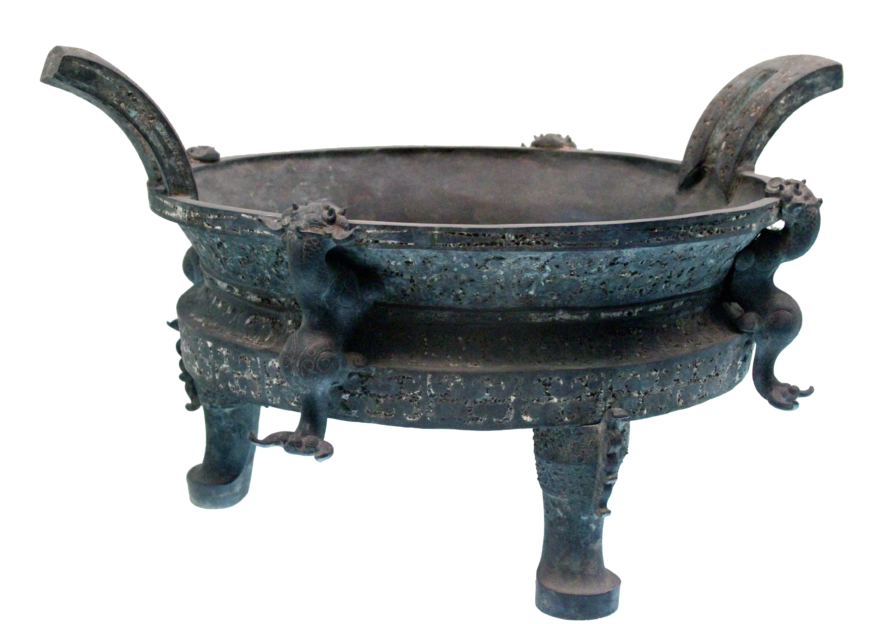
Bronze ding, Tomb of Marquis Yi of Zeng (Leigudun Tomb 1), Warring States period, late 5th century B.C.E., Suixian, Hubei, China (Hubei Provincial Museum; photo: Gary Todd)
Ritual Bronze Vessels
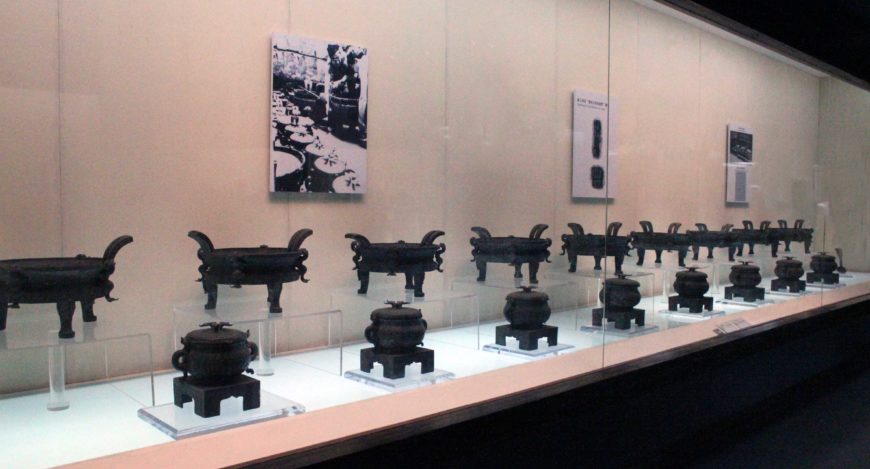
Bronze vessels from the tomb at Hubei Provincial Museum. This display gives an indication of how many vessels were found in the tomb. Tomb of Marquis Yi of Zeng (Leigudun Tomb 1), Warring States period, late 5th century B.C.E., Suixian, Hubei, China (Hubei Provincial Museum; photo: Gary Todd)
Meticulously lined up in the southern end of the tomb’s central chamber are many bronze vessels, which are breathtaking for their sheer scale, volume, and technical virtuosity. Ritual bronze vessels like these were used in ancestral offering ceremonies in Bronze Age China. The correct performance would please the ancestors, and strengthen elite status and power in return. Food offerings were the primary form of ancestral offerings in Bronze Age China. Often human sacrifice, especially that of war captives, was a key component in the offering ceremony. The the vessels for offerings in the tomb of the Marquis Yi are considered one of the most impressive examples.
Beginning in the middle to late Western Zhou period (c. 9th century B.C.E.), a loose ranking system emerged to regulate the ritual bronze use in accordance with someone’s prescribed elite status. The more bronze vessels you had, the higher your status. The king of the Zhou court (at the top of the social hierarchy) supposedly used 9 ding-cauldrons and 8 gui-basins, and his subordinate lords and princes were entitled to fewer vessels. The ding food-cauldron (which typically contained sacrificed animals) and the gui grain-basin were the centerpieces of the ritual paraphernalia for ancestral offering in Bronze Age China.
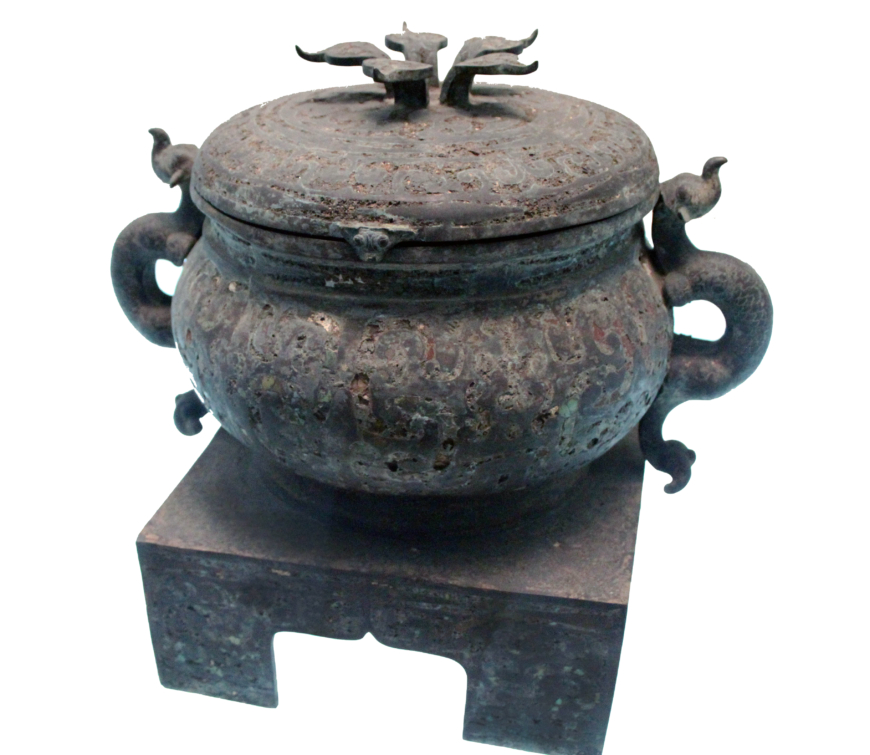
Bronze Gui, Tomb of Marquis Yi of Zeng (Leigudun Tomb 1), Warring States period, late 5th century B.C.E., Suixian, Hubei, China (Hubei Provincial Museum; photo: Gary Todd)
This regulative system began to relax in the late first millennium B.C.E., as we see with the marquis’s tomb. In it we find 9 ding-cauldrons and 8 gui-basins in the central chamber. They reveal the aspiration of Marquis Yi for a status beyond his reach as the ruler of a small southern state. Echoing the ritual relaxation at this time was the simplification and secularization of the bronze inscriptions. Most of Marquis Yi’s bronzes bear the simple inscription “Marquis Yi of Zeng makes, holds, and uses forever.” This inscription signals the broader shift from commemorative writing of the previous Western Zhou period to the straightforward indication of ownership in the Warring States period.
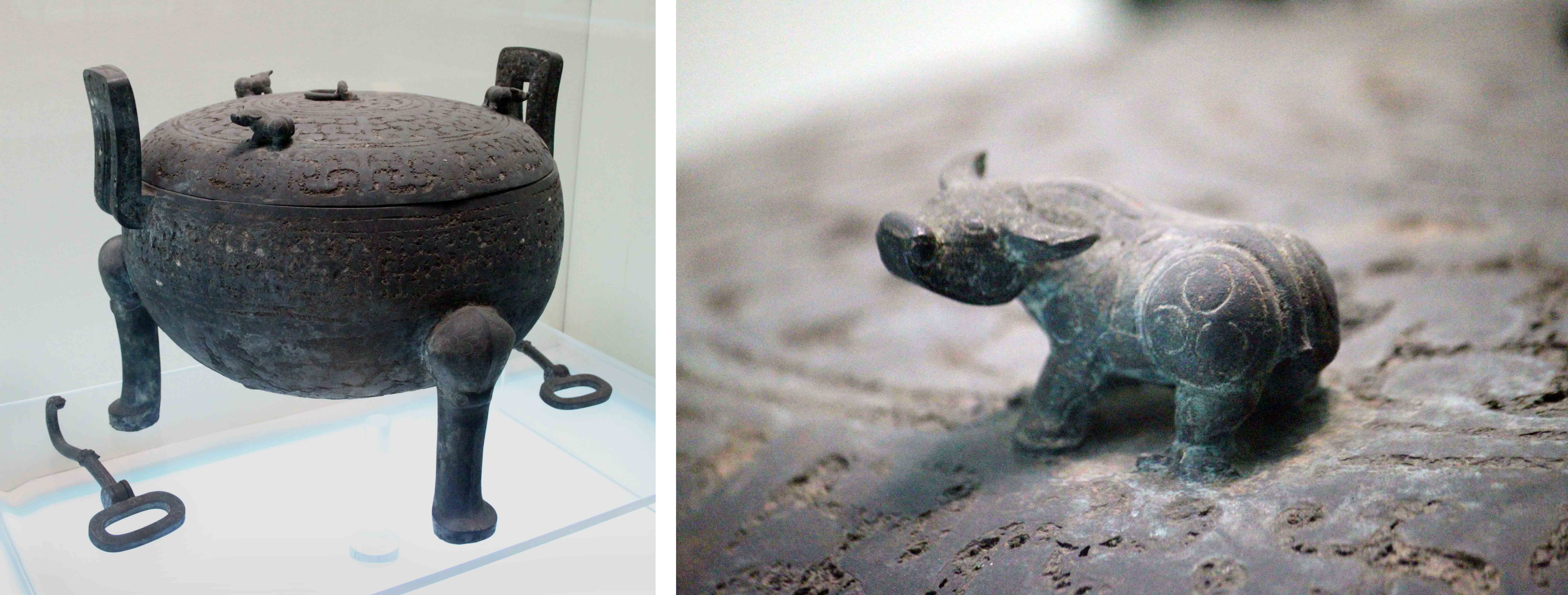
Left: bronze lidded ding, Tomb of Marquis Yi of Zeng (Leigudun Tomb 1), Warring States period, late 5th century B.C.E., Suixian, Hubei, China (Hubei Provincial Museum; photo: Gary Todd); right: detail of bronze lidded ding, Tomb of Marquis Yi of Zeng (Leigudun Tomb 1), Warring States period, late 5th century B.C.E., Suixian, Hubei, China (Hubei Provincial Museum; photo: Gary Todd)
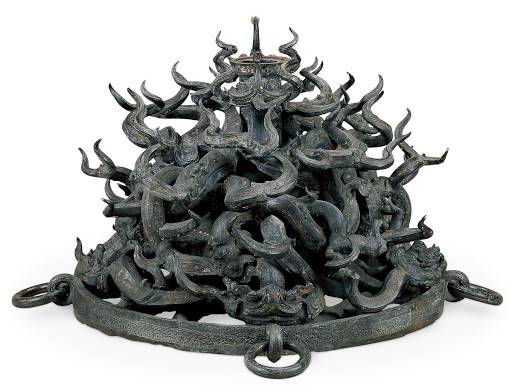
Bronze drum base, Tomb of Marquis Yi of Zeng (Leigudun Tomb 1), Warring States period, late 5th century B.C.E., Suixian, Hubei, China (Hubei Provincial Museum)
Marquis Yi’s bronzes represent the finest technical achievements in ancient bronze casting. Traditional piece-mold casting first emerged in the middle Yellow River valley in the early second millennium B.C.E. This technique was still practiced in the Zeng state foundry and accounts for most of Marquis Yi’s bronzes. The most spectacular of this long-established casting method is the bronze drum base. A swarm of burly serpents vigorously swirl up from the circular base and appear to be boldly exhibiting their brawny physiques in response to music. Each serpent was individually cast and then joined together.
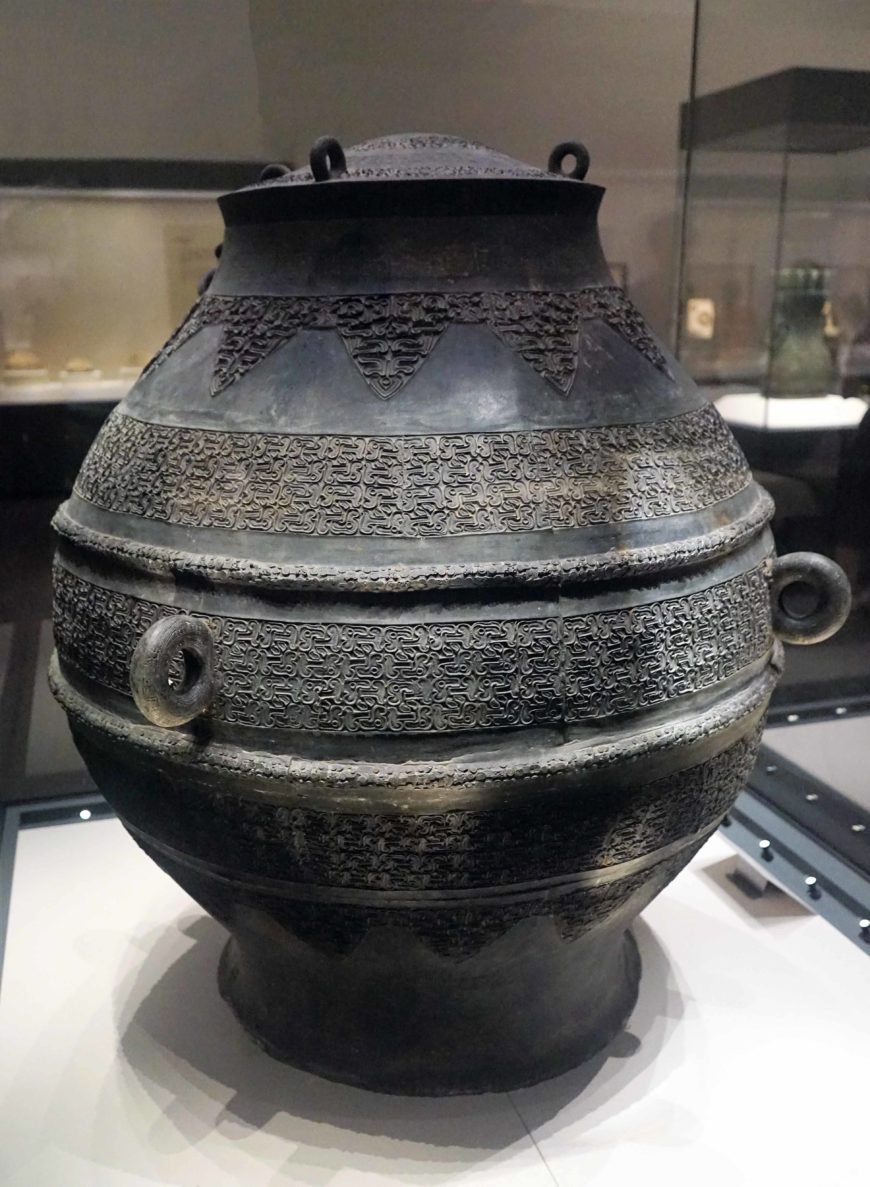
Bronze wine storage vessel, Tomb of Marquis Yi of Zeng (Leigudun Tomb 1), Warring States period, late 5th century B.C.E., Suixian, Hubei, China, 1.30 m in height and 1.10 m in width (Hubei Provincial Museum; photo: Cangminzho, CC BY-SA 4.0)
Another technical masterpiece of piece-mold casting is a pair of wine storage jars, which are the most voluminous bronze vessels in the tomb. Their immense volume prevented the founders from completing the casting in one attempt. A wide band that runs through the middle of the vessel body indicates that the upper and lower half were cast separately and joined together afterward.
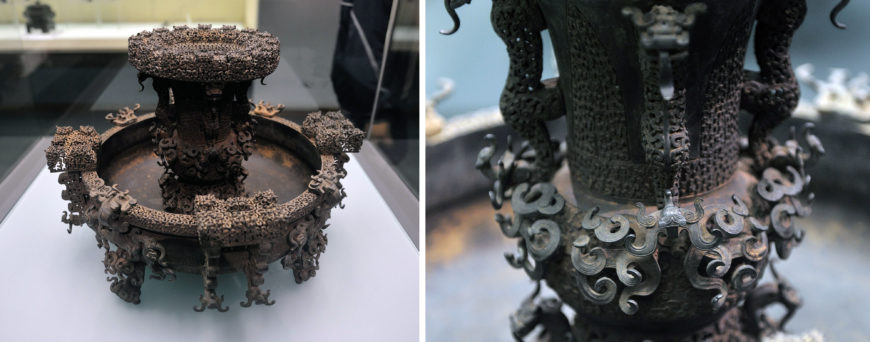
Bronze zun-pan basin and vase. The pan held ice, while the zun held wine. Tomb of Marquis Yi of Zeng (Leigudun Tomb 1), Warring States period, late 5th century B.C.E., Suixian, Hubei, China (Hubei Provincial Museum; photo: Siyuwj, CC BY-SA 4.0)
Outside the piece-mold casting, the Zeng state casters also mastered other production methods. Archaeologists usually credit the zun–pan basin and vase set to lost-wax casting. The rim, which appears to be thick and full, consists of intensive miniaturized serpents that curl up and interlace with each other. These intricate designs, especially the deep undercuts and three-dimensional layerings, are nearly technically impossible in piece-mold casting. In addition, the Zeng casters employed copper and lead soldering to connect accessories such as handles, knobs, and legs to the main body of bronze vessels.
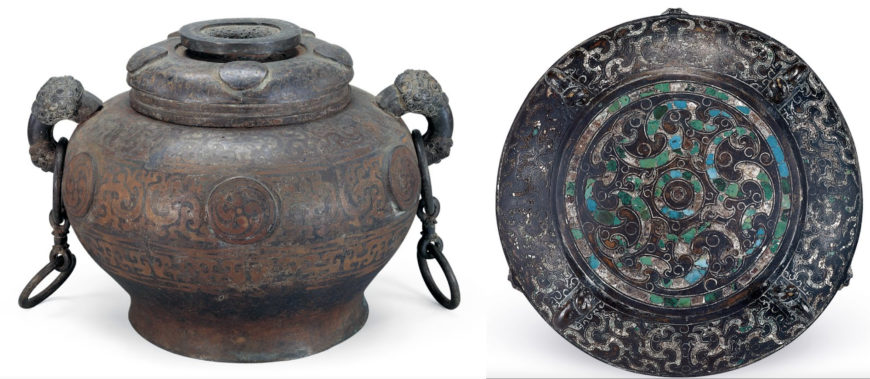
Ritual bronze guanfo-basin (left) inlaid with red copper and a dou-stemmed bowl (right) with turquoise ornaments, Tomb of Marquis Yi of Zeng (Leigudun Tomb 1), Warring States period, late 5th century B.C.E., Suixian, Hubei, China (Hubei Provincial Museum)
Inlay also played a prominent role in decorating Marquis Yi’s bronzes. There are ritual bronze sacrificial food vessels inlaid with red copper or even turquoise ornaments. In both cases, the Zeng founders first cast the bronze vessel with pre-arranged negative grooves. They then cast the copper and inserted the turquoise in the intaglio lines before finally polishing up the surface of the vessel.
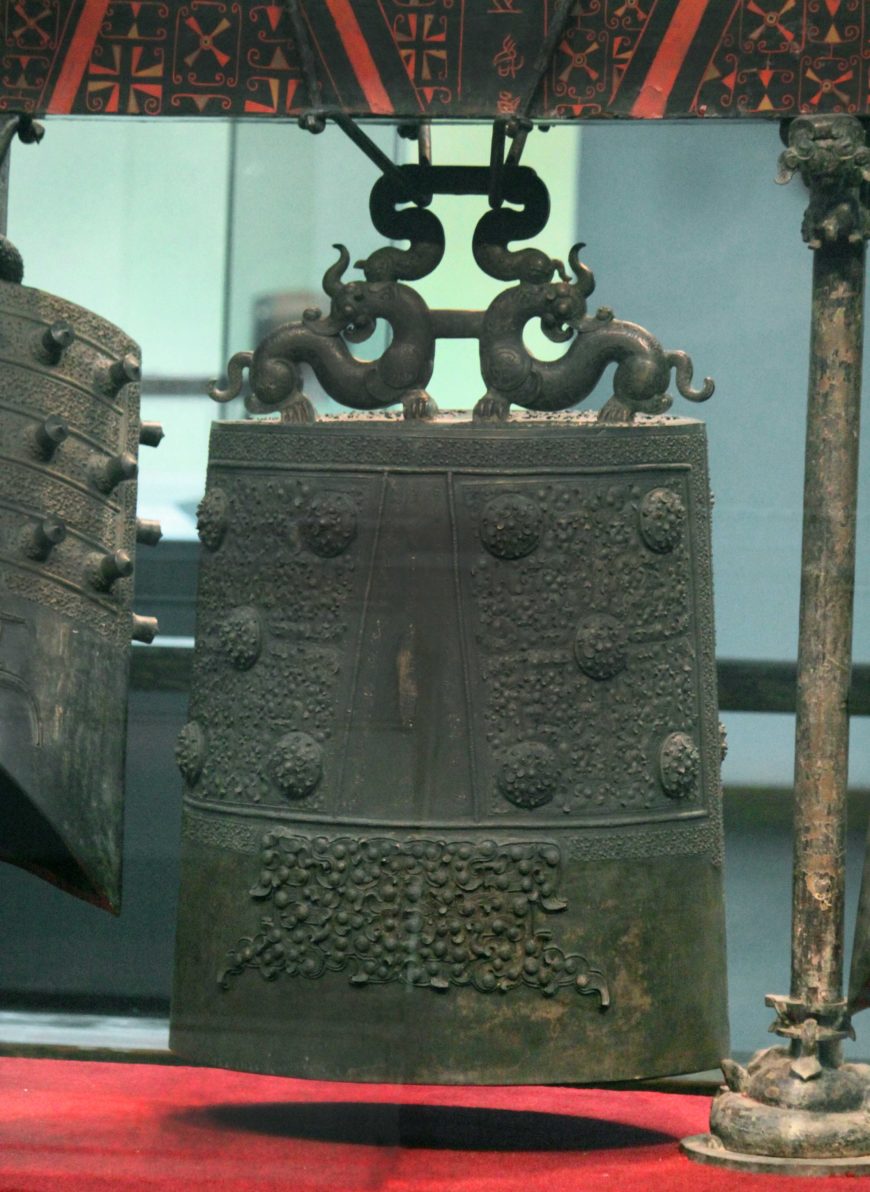
Bo-bell with a 31-character inscription, Tomb of Marquis Yi of Zeng (Leigudun Tomb 1), Warring States period, late 5th century B.C.E., bronze and lacquer, Suixian, Hubei, China (Hubei Provincial Museum; photo: Gary Todd)
Regional politics
Beyond revealing to us the wealth and ambition of the marquis, certain items in the tomb also tell us about regional politics and trans-regional, Eurasian connections. One bell from the bell chime set shows us how one local ruler of a small state was well-connected to more powerful rulers and larger states than Zeng.
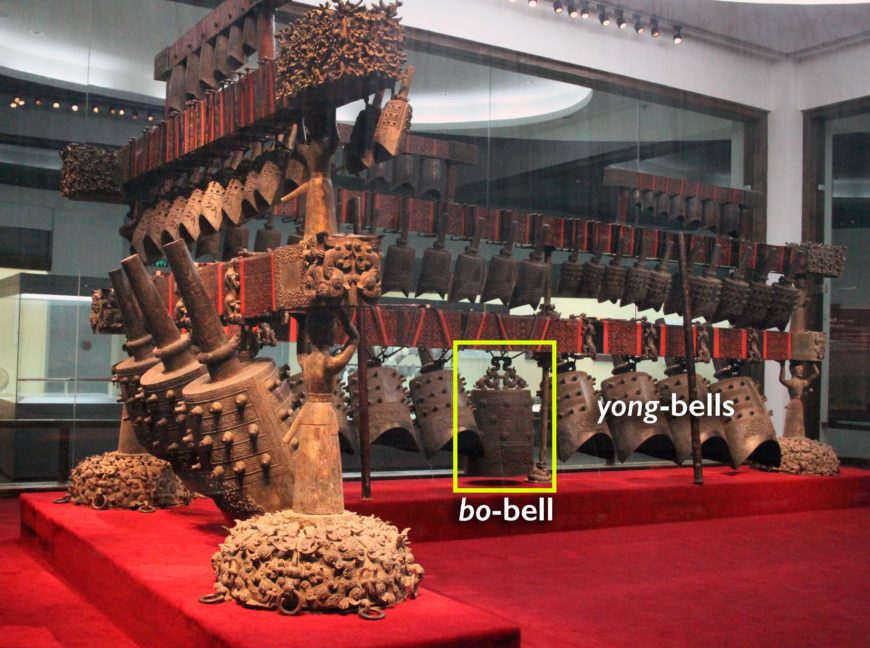
Chime bell set, Tomb of Marquis Yi of Zeng (Leigudun Tomb 1), Warring States period, late 5th century B.C.E., bronze and lacquer, Suixian, Hubei, China (Hubei Provincial Museum; photo: Gary Todd)
In the center of the chime bell set is a sizable bronze bo-bell with a straight rim that looks different from the other yong-bells (with concave rims) surrounding it. The vertical hanging pose of this central bo-bell also stands out from the uniform tilted suspension seen across the racks holding all the bells. An inscription on the bo-bell indicates that it was a present from Xiong Zhang, the King Hui of the Chu state.
What did this gift mean for Marquis Yi?
The bo-bell indicates the importance of political strategizing during this time—by gifting it to the Marquis Yi of Zeng the nearby Chu king implies that the Zeng state was under the Chu protection (or even that Zeng was a client state to the Chu). The incorporation of the bell into the larger chime bell set suggests that Marquis Yi accepted the political patronage from the Chu state. While the gift suggests Marquis Yi had to compromise some of his power, his burial arrangement also appropriated kingly ritual prestige items like the 9 ding and 8 gui, which were usually reserved for the Zhou ruler. Borrowing from the kingly ritual bronze setting was more of a ceremonial rather than a political statement. Though he probably had less respect for the authority of the central Zhou court, Marquis Yi was not intending to usurp the throne and seize actual power.
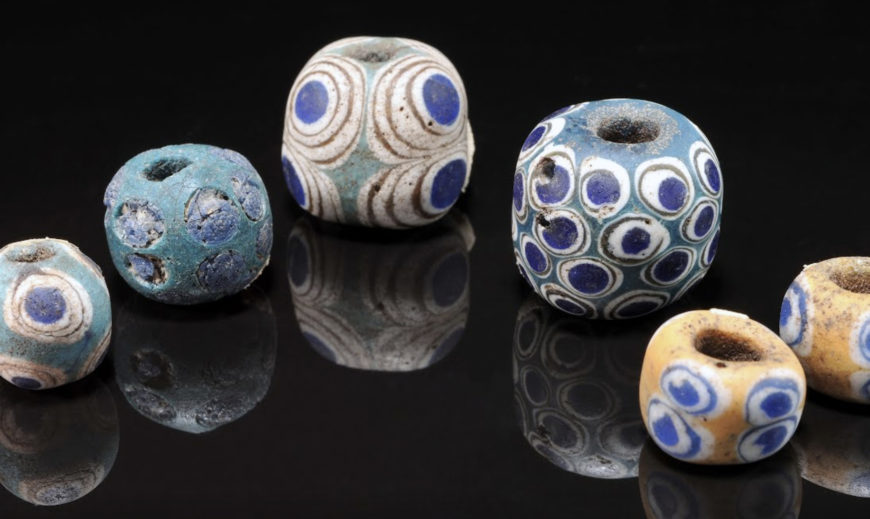
Beads with “dragonfly-eye” designs, soda-lime glass, Tomb of Marquis Yi of Zeng (Leigudun Tomb 1), Warring States period, late 5th century B.C.E., Suixian, Hubei, China (Hubei Provincial Museum)
Eurasian Connections
Certain objects in the tomb speak to the increased cultural exchange across the Eurasian continent at this time. 172 glass compound eye beads discovered in the inner coffin were the result of a wave of transcontinental communication. These glass beads, known as the “dragonfly eyes,” were a short-lived fad in Warring States China. Commonly featuring blue concentric circles in bright green or yellow background, compound eye beads find their earlier counterparts in Egypt, Iran, and the eastern Mediterranean. Raman spectroscopy examination shows that the colorants of Marquis Yi’s beads are primarily calcium- and sodium-based, which share similar chemical compositions with beads from West Asia. They were likely directly imported from the west. Soon Chinese craftsmen adopted the form of the exotic glass beads and achieved a comparable look with the locally sourced lead and barium.
Recent archaeological excavations have unveiled matching glass beads in Scythian burials in Central Asia, implying that the nomads living in the Steppe played a vital role in the long-distance dissemination of the compound eye beads.
From massive burial chambers and gigantic double coffins to grand bronze vessels and chime bells, the tomb of Marquis Yi comprehensively reveals to us the splendid and sophisticated elite life in the Warring States period. All these rich furnishings expressively display the power and wealth of Marquis Yi and enabled his prestige and privilege to continue in the afterlife.
Additional resources
“China, 1000 B.C.–1 A.D.,” Heilbrunn Timeline of Art History, Metropolitan Museum of Art
“Resound: Ancient Bells of China,” National Museum of Asian Art, Smithsonian
Bells of Ancient China, National Museum of Asian Art, Smithsonian
“Introduction to Tomb of Marquis Yi of Zeng,” Hubei Provincial Museum
The Marquis Yi of Zeng, Bronze Objects, on Google Arts and Culture
The Marquis Yi of Zeng, Gold and Jade Objects, on Google Arts and Culture

